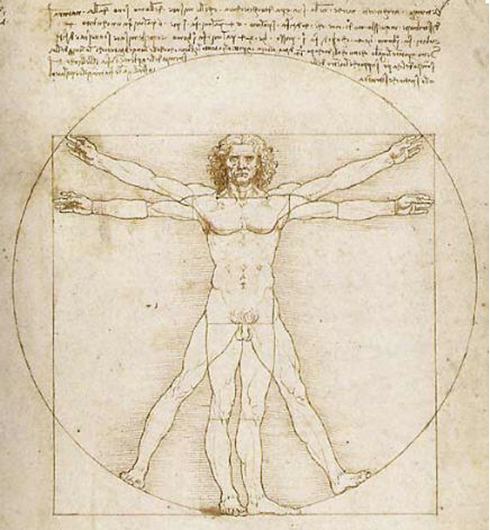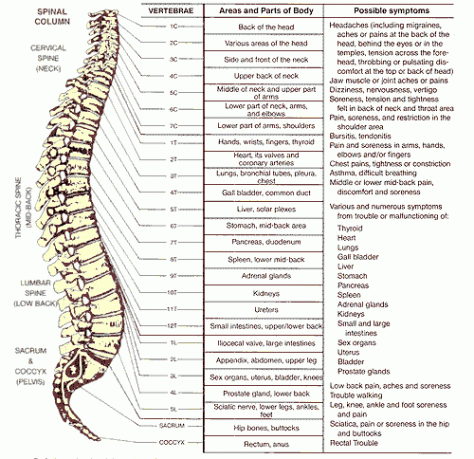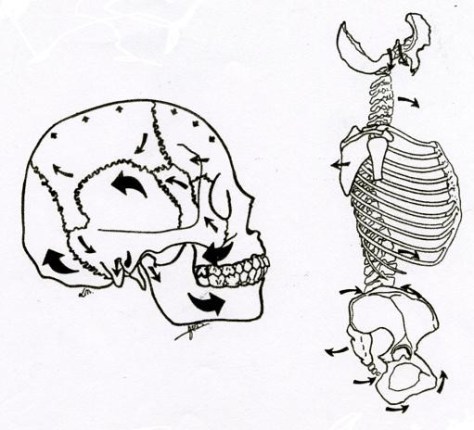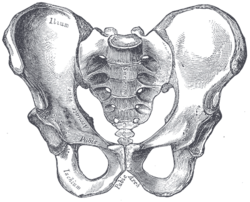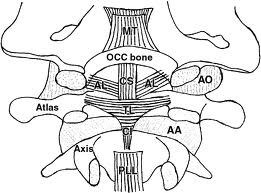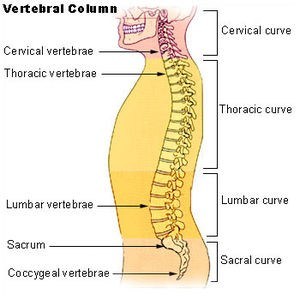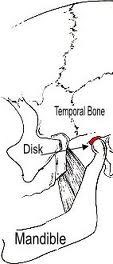Our body has the ability to heal itself and maintain a healthy state. Also, our body is designed so that systems work together to sustain symmetry and balance which in turn enables normal function of systems. There are many research findings which link biological fitness and balanced body structure. In essence, balance and control define a healthy body.
It can be said that all our body systems are interlinked and abnormality in one system can lead to the failure of another. This is also the case for our structure and communication function; they are closely linked. Below is a diagram of our spinal nervous system which shows how the spine, nerves, muscles and organs are connected.
Our central nervous system consists of the brain and the spinal cord which as the word suggests is inside the spine.
Therefore, normal function of these nerves may be disturbed by misalignment of the vertebrae (also known as subluxation) in our spine. Below shows each vertebra and related parts as well as possible symptoms from subluxation.
As the diagram above demonstrates, it can be said that problems with structure and nervous system co exist in many patients suffering from chronic conditions. Therefore, stabilization of the nervous system cannot be permanent unless the structural problem is resolved.
Before proceeding to understand the importance of TMJ and how it impacts body structure, it is useful to comprehend the role of TMJ and the following key components which Dr Lee refers to as 3 balance points in our body.
1. Cranium
In a healthy cranial structure, there is a contracting and expanding movement, called cranial rhythmic impulse (or primary respiratory mechanism). This impulse consists of a number of simultaneous motions:
- Expansion and contraction of the cranial bones and the meninges surrounding them.
- Pressure changes in the cerebrospinal fluid system, which moves back and forth within the central nervous system, i.e. from the cranium to sacrum and back.
- And the cranial motion works together with a contrary motion in the sacrum.
Cranial rhythmic impulse is coupled with our diaphragmatic respiration and is vital in proper brain-body communication.
2. Pelvis (Sacrum)
The pelvis (or pelvic girdle) is a bilaterally symmetrical structure of bonus (sacrum, os coxa, and coccyx), muscles, and interconnecting tissue.
- It supports and protects the abdomen as well as several organs in the abdomen.
- The pelvis provides a foundation for the legs.
- It also supports the trunk of the body via the sacrum, which is connected to the spine.
Understanding of our spine is also important and Dr Lee puts most emphasis on the first two vertebrae of the spine:
3. Spine
3.1 Occipito atlantoaxial joint = C1 & C2
The occipito atlantoaxial joint consists of the occiput, the Atlas (C1) and Axis (C2). In other words: the upper cervical vertebrae connecting with the cranium.
- In the normal situation, these are neatly stacked on top of one another, in perfect symmetry, allowing unobstructed movement of the head and neck in all directions.
- Also, in the normal situation, the brain-body communication will function perfectly via the vertebral and carotid arteries, the lymphatic system, the cerebrospinal fluid, the meningeal system and the spinal cord.
Especially the second vertebra C2, is a pivotal point since all muscles in head and neck are focused towards it.
3.2 Rest of the spine
In a healthy body, cervical, thoracic and lumbar spine are well aligned with two typical curvatures as can seen from the side, giving the spine an S-shape.
- The correct structure allows for flexible movement and optimal support of the entire upper body, as well as maximum shock absorption power.
- Another very important function of the spine is protection of the spinal cord and spinal nerves.
Temporomandibular Joint (TMJ)
There are two temporomandibular joints (TMJ), one on either side. A healthy TMJ is mainly recognized as follows:
- The mandible is aligned in all directions. i.e., there is no shift in the horizontal plane, and no shift in vertical direction.
- The disk in the TMJ is in place and has not been deformed, thus allowing optimal function of the nerves, arteries and veins passing at the joint.
- When the mandible opens and closes, the TMJ disk stays in place, allowing smooth motion, without the ball and socket of the joint touching, so that there are no clicking and/or grinding sounds.
The following are reasons why Dr Lee puts so much importance on the joint:
1. General role of TMJ
TMJ is part of the masticatory system and is responsible for the following three functions: 1) mastication (chewing), phagia (swallowing) and speech. The masticatory system generally includes teeth, periodontal ligament, lips and tongue, cheeks, palate, TMJ and other related tissues.
2. Distinctive function of TMJ
TMJ is a joint which works 24 hours a day. Even during sleep, TMJ is the only joint which is in motion constantly. Therefore, the continuous movement of TMJ is not just a simple exercise but is necessary in maintaining life. It can be said that body organs which work persistently even during sleep are brain, heart, lungs and TMJ. Other organs such as trachea (airway), joints, spine and muscles all rest during sleep and there is a distinctive reason for why the four organs (brain, heart, lungs and TMJ) have to work throughout day and night. Firstly, the heart has to pump without a break to supply blood to the rest of the body which is essential in sustaining life. The lungs also are required to move consistently to maintain breathing. If the lungs stop and prevent breathing, the brain also stops functioning within minutes. The brain has to keep vigilant of the functions of the rest of the body even while we sleep.
So what is the reason for consistent movement of TMJ? During sleep, we swallow every minute (on average). Even though we are sleeping, the molar teeth on the upper and lower mandible are in contact every time we swallow which creates around 3.5 lb worth of biting force. This biting force is transported to the core part of the brain and supplies energy allowing normal function of the brain. Also, it is assumed that the force creates motility to sphenoid bone (located at the bottom of the brain) which is connected to the lower mandible and allows circulation of cerebrospinal fluid. The brain respires orderly only when the cerebrospinal fluid flows properly.

